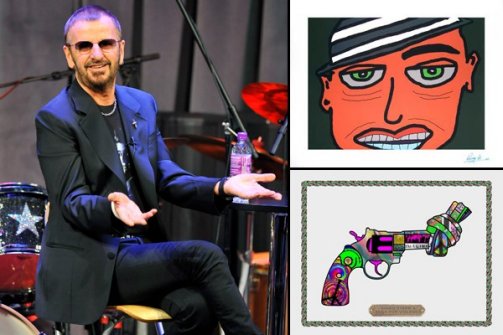Spend $99.00 get Free Shipping on anything gets free shipping option USA only
Profile
Search
Shopping cart
You have no items in your shopping cart.
Ringo Starr Is Selling His Pictures and Donating the Proceeds to Charities
03 July, 2012 - 0 Comments

On a rainy Monday night in New York, Ringo Starr is opening the latest show of his rock-star art, and he’s looking great. In skinny black pants, an Edwardian jacket and a stylish cropped beard, he seems more like 50 than 71, as everyone around him remarks. He still has his laddish Liverpudlian wit, throwing back his head in a deep throaty laugh as a crowd of reporters joins in. His creative streak is still streaking: He’s on yet another U.S. tour with his All Starr Band, while Pop International, a SoHo gallery that sells celebrity art, is crammed with his computer-printed creations, greeted with oohs and aahs (and checks) by the throng of fans in attendance.
But Ringo’s got a problem. He gets such automatic praise and attention, just for being the Fourth Beatle, that it doesn’t much matter what he does or makes, the effect on the crowd is the same. His jokes aren’t as funny as he or his fans pretend—and it doesn’t matter. (Noting that a downpour has ended, Ringo gets a roar of laughter when he quips “I just said stop and it did.”) His childlike pictures, which each take a minute or two to make on an iPad (“I started because there was down-time in hotels”) are within the talents of every one of their buyers–and that doesn’t matter either, because they didn’t in fact make them, the Beatles’ drummer did.
“Ringo Starr–I didn’t expect to see him when I woke up this morning,” says Will Darbanville, a 20-year-old from Wilton, Conn., who happened on the crowd that had gathered for the drummer’s arrival. “You don’t get a better name-drop than that.”
“I have Beatles albums all over my room,” says his friend Allie Rizzo, who is 19—born, that is, 31 years after Ringo joined her “favorite band of all time.”
But here’s where Ringo has had real inspiration: He’s used his foolproof success as a kind of art supply, to make pictures that matter and are up to date.
Every work of art he sells–every goofy cartoon face, every peace-sign drum skin, every crude psychedelic abstraction—helps fund the Lotus Foundation, set up 11 years ago by him and his wife, Barbara Bach. “We’re trying to help. We’re trying to do the best that we can,” he tells me, in a rare quiet moment in the gallery’s back room. (He peppers his talk with snippets of Beatles lyrics—a shtick that can seem strangely contrived and needy.) The foundation passes the art’s proceeds to the big NGO WaterAid—“I think everybody should at least have water”—as well as to various British and African charities.
“It's a win-win, really. I enjoy doing [the art], I enjoy selling it, and I enjoy receiving [the money] into the charity. So it's a really cool thing," says Ringo. It’s also just what cutting-edge artists are up to these days. Rather than finding yet another novel way to turn out beautiful objects—something Ringo certainly hasn’t done—these artists turn social action into their art. At the great Documenta art festival that opened this month in Germany, a New York artist named Robin Kahn surrendered her exhibition space to refugee women from the western Sahara. Rirkrit Tiravanija, a major art-world figure, has created a compound in his native Thailand where artists and farmers can work and live; on a smaller scale, he’ll simply cook a big curry dinner and invite random people to eat. The art is in the generous communal moment he creates, rather than in the very ordinary curry he serves. He’s part of a movement that is about intervening in the world of human relations, making them richer and better—hence the phrase “relational aesthetics” that’s often attached to it. Ringo may be rock’s first relational aesthetician.
The drummer’s not making grand claims for the actual objects he makes, and neither could anyone else. Ringo's art is not in the pictures he makes. It's in how well they sell, and the cause that they serve. Most are just the output from an ink-jet printer (the gallery prefers the frenchified phrase “giclée prints”), blown up to various sizes, on various surfaces, at all kinds of price points. The anti-violence icon of a gun with a knot in its barrel, merely colored in by Ringo (“I was asked if I’d decorate one”), goes for $6,500 in an over-the-sofa version output on canvas. The same thing costs $2,950 for a medium-size print on paper (with two guns and the added inscription “Ringo Starr is Knot for Violence”) and $2,500 for one gun at 11” by 14”. At the opening, where the gallery says that the show almost sold out, a bouncer was yanking canvases off the wall for Ringo to sign, hauling them around like sides of beef, and Ringo is no more precious about them. “It’s all merchandise now,” he says, adding that his art mostly gets sold to the fans at his gigs. “They can buy a painting or a t-shirt”—or, more recently, a skin for a bass drum with Ringo’s art on it. You could argue that the less challenging and notable his pictures are, the better they sell, and the more Documenta-worthy they may therefore be. “It’s all for charity … I am just for peace and love, for God’s sake.”
Spoken like a serious artist.
You can read the original article HERE
Comments (0)



